Jackson M.J. Micro and Nanomanufacturing
Подождите немного. Документ загружается.

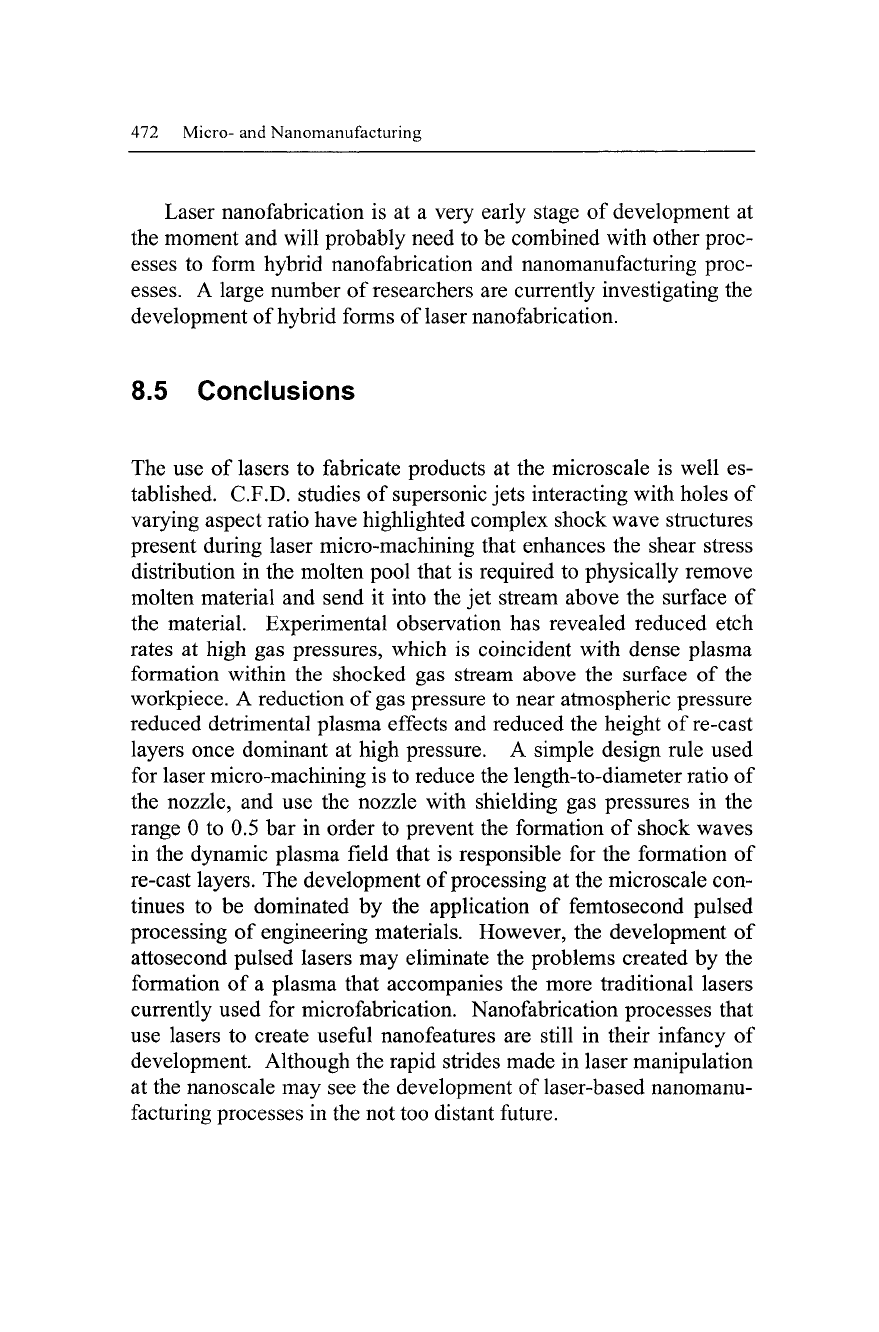
472 Micro- and Nanomanufacturing
Laser nanofabrication is at a very early stage of development at
the moment and will probably need to be combined with other proc-
esses to form hybrid nanofabrication and nanomanufacturing proc-
esses.
A large number of researchers are currently investigating the
development of hybrid forms of laser nanofabrication.
8.5 Conclusions
The use of lasers to fabricate products at the microscale is well es-
tablished. C.F.D. studies of supersonic jets interacting with holes of
varying aspect ratio have highlighted complex shock wave structures
present during laser micro-machining that enhances the shear stress
distribution in the molten pool that is required to physically remove
molten material and send it into the jet stream above the surface of
the material. Experimental observation has revealed reduced etch
rates at high gas pressures, which is coincident with dense plasma
formation within the shocked gas stream above the surface of the
workpiece. A reduction of gas pressure to near atmospheric pressure
reduced detrimental plasma effects and reduced the height of re-cast
layers once dominant at high pressure. A simple design rule used
for laser micro-machining is to reduce the length-to-diameter ratio of
the nozzle, and use the nozzle with shielding gas pressures in the
range 0 to 0.5 bar in order to prevent the formation of shock waves
in the dynamic plasma field that is responsible for the formation of
re-cast layers. The development of processing at the microscale con-
tinues to be dominated by the application of femtosecond pulsed
processing of engineering materials. However, the development of
attosecond pulsed lasers may eliminate the problems created by the
formation of a plasma that accompanies the more traditional lasers
currently used for microfabrication. Nanofabrication processes that
use lasers to create useful nanofeatures are still in their infancy of
development. Although the rapid strides made in laser manipulation
at the nanoscale may see the development of laser-based nanomanu-
facturing processes in the not too distant future.
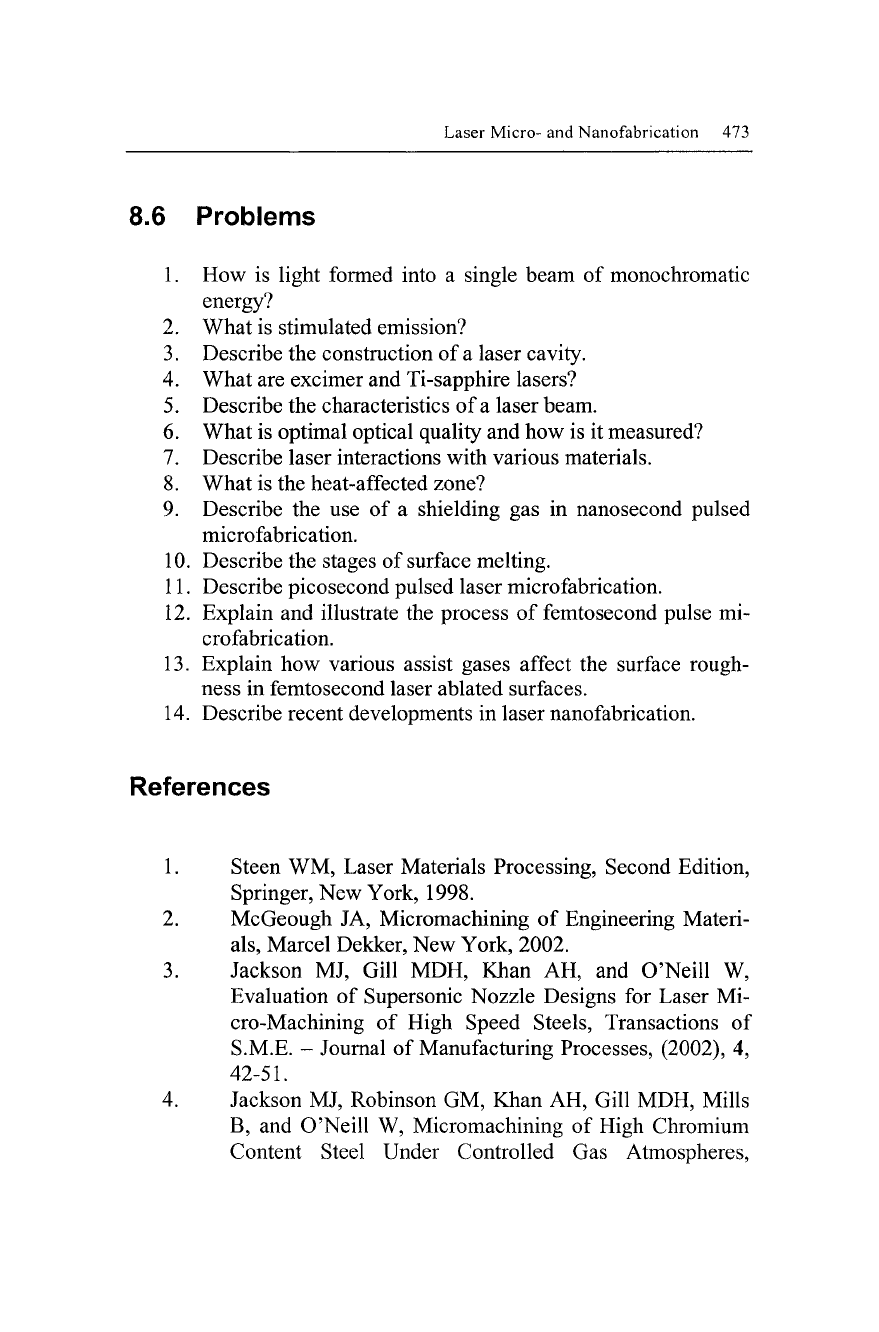
Laser Micro- and Nanofabrication 473
8.6 Problems
1.
How is light formed into a single beam of monochromatic
energy?
2.
What is stimulated emission?
3.
Describe the construction of a laser cavity.
4.
What are excimer and Ti-sapphire lasers?
5.
Describe the characteristics of a laser beam.
6. What is optimal optical quality and how is it measured?
7.
Describe laser interactions with various materials.
8. What is the heat-affected zone?
9. Describe the use of a shielding gas in nanosecond pulsed
microfabrication.
10.
Describe the stages of surface melting.
11.
Describe picosecond pulsed laser microfabrication.
12.
Explain and illustrate the process of femtosecond pulse mi-
crofabrication.
13.
Explain how various assist gases affect the surface rough-
ness in femtosecond laser ablated surfaces.
14.
Describe recent developments in laser nanofabrication.
References
Steen WM, Laser Materials Processing, Second Edition,
Springer, New York, 1998.
McGeough JA, Micromachining of Engineering Materi-
als,
Marcel Dekker, New York, 2002.
Jackson MJ, Gill MDH, Khan AH, and O'Neill W,
Evaluation of Supersonic Nozzle Designs for Laser Mi-
cro-Machining of High Speed Steels, Transactions of
S.M.E. - Journal of Manufacturing Processes, (2002), 4,
42-51.
Jackson MJ, Robinson GM, Khan AH, Gill MDH, Mills
B,
and O'Neill W, Micromachining of High Chromium
Content Steel Under Controlled Gas Atmospheres,
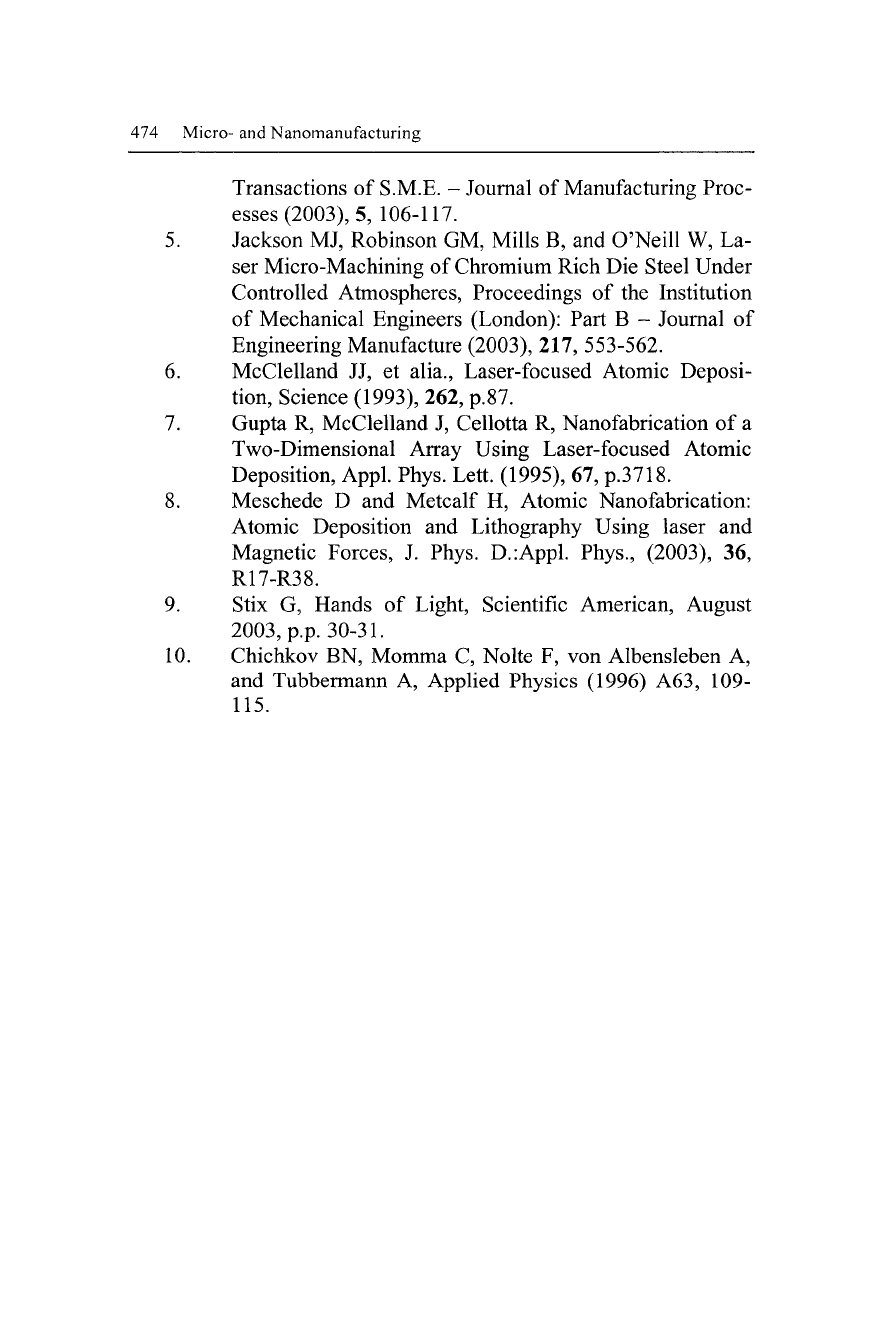
474 Micro- and Nanomanufacturing
Transactions of S.M.E. - Journal of Manufacturing Proc-
esses (2003), 5, 106-117.
5.
Jackson MJ, Robinson GM, Mills B, and O'Neill W, La-
ser Micro-Machining of Chromium Rich Die Steel Under
Controlled Atmospheres, Proceedings of the Institution
of Mechanical Engineers (London): Part B - Journal of
Engineering Manufacture (2003), 217, 553-562.
6. McClelland J J, et alia., Laser-focused Atomic Deposi-
tion, Science (1993), 262, p.87.
7.
Gupta R, McClelland J, Cellotta R, Nanofabrication of a
Two-Dimensional Array Using Laser-focused Atomic
Deposition, Appl. Phys. Lett. (1995), 67, p.3718.
8. Meschede D and Metcalf H, Atomic Nanofabrication:
Atomic Deposition and Lithography Using laser and
Magnetic Forces, J. Phys. D.:Appl. Phys., (2003), 36,
R17-R38.
9. Stix G, Hands of Light, Scientific American, August
2003,
p.p.
30-31.
10.
Chichkov BN, Momma C, Nolte F, von Albensleben A,
and Tubbermann A, Applied Physics (1996) A63, 109-
115.
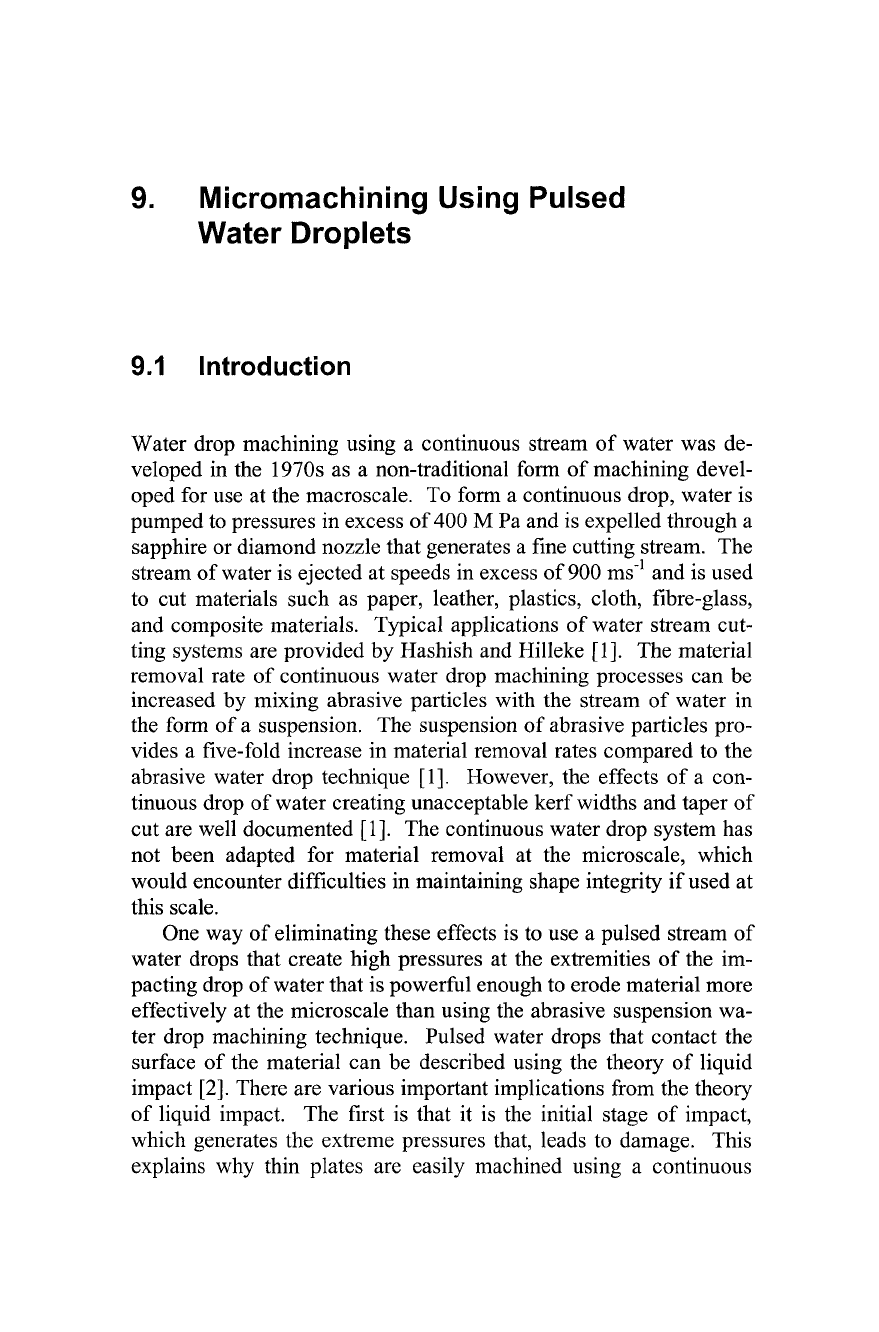
9.
Micromachining Using Pulsed
Water Droplets
9.1 Introduction
Water drop machining using a continuous stream of water was de-
veloped in the 1970s as a non-traditional form of machining devel-
oped for use at the macroscale. To form a continuous drop, water is
pumped to pressures in excess of 400 M Pa and is expelled through a
sapphire or diamond nozzle that generates a fine cutting stream. The
stream of water is ejected at speeds in excess of 900 ms"^ and is used
to cut materials such as paper, leather, plastics, cloth, fibre-glass,
and composite materials. Typical applications of water stream cut-
ting systems are provided by Hashish and Hilleke [1]. The material
removal rate of continuous water drop machining processes can be
increased by mixing abrasive particles with the stream of water in
the form of a suspension. The suspension of abrasive particles pro-
vides a five-fold increase in material removal rates compared to the
abrasive water drop technique [1]. However, the effects of a con-
tinuous drop of water creating unacceptable kerf widths and taper of
cut are well documented [1]. The continuous water drop system has
not been adapted for material removal at the microscale, which
would encounter difficulties in maintaining shape integrity if used at
this scale.
One way of eliminating these effects is to use a pulsed stream of
water drops that create high pressures at the extremities of the im-
pacting drop of water that is powerful enough to erode material more
effectively at the microscale than using the abrasive suspension wa-
ter drop machining technique. Pulsed water drops that contact the
surface of the material can be described using the theory of liquid
impact [2]. There are various important implications from the theory
of liquid impact. The first is that it is the initial stage of impact,
which generates the extreme pressures that, leads to damage. This
explains why thin plates are easily machined using a continuous
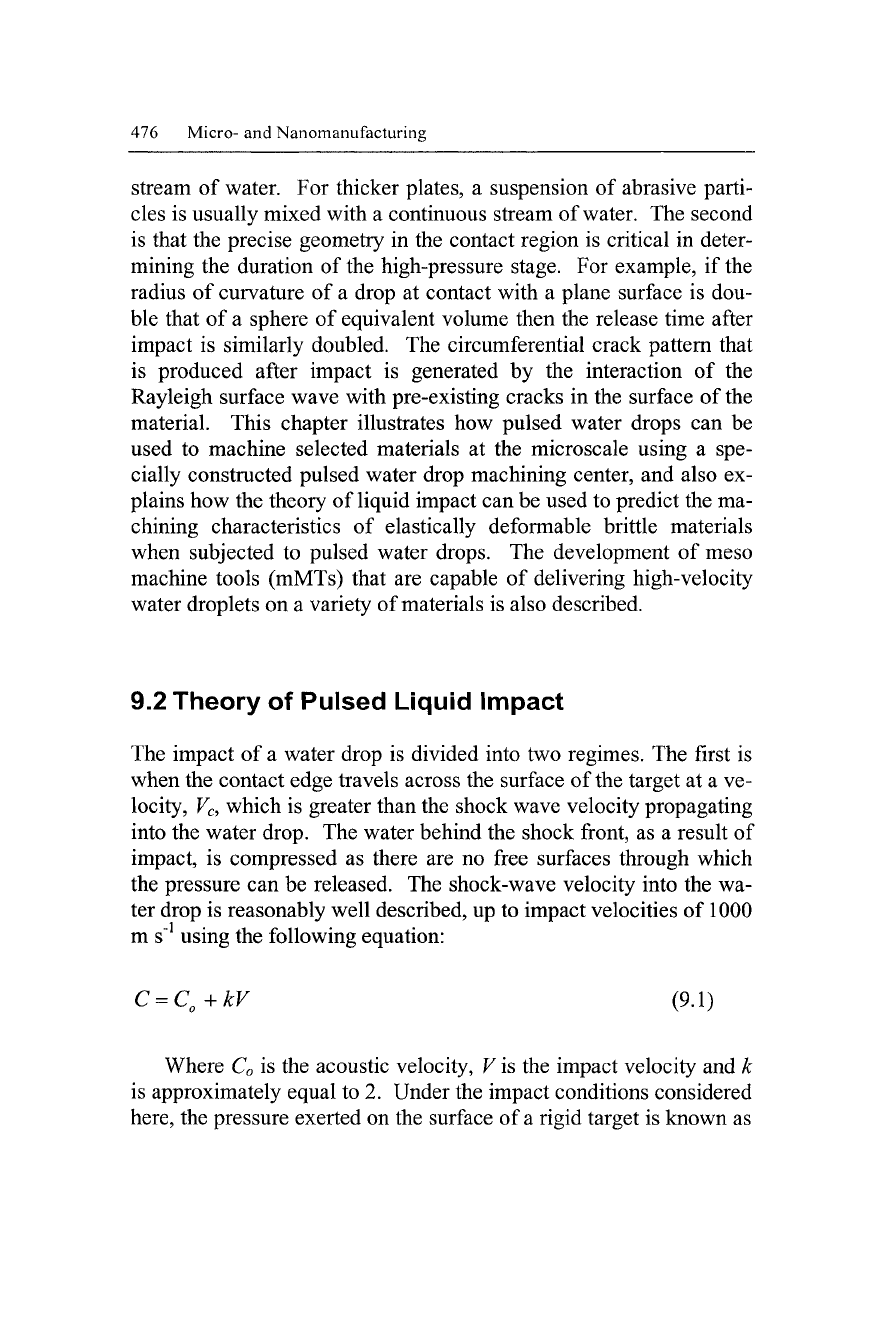
476 Micro- and Nanomanufacturing
stream of water. For thicker plates, a suspension of abrasive parti-
cles is usually mixed with a continuous stream of water. The second
is that the precise geometry in the contact region is critical in deter-
mining the duration of the high-pressure stage. For example, if the
radius of curvature of a drop at contact with a plane surface is dou-
ble that of a sphere of equivalent volume then the release time after
impact is similarly doubled. The circumferential crack pattern that
is produced after impact is generated by the interaction of the
Rayleigh surface wave with pre-existing cracks in the surface of the
material. This chapter illustrates how pulsed water drops can be
used to machine selected materials at the microscale using a spe-
cially constructed pulsed water drop machining center, and also ex-
plains how the theory of liquid impact can be used to predict the ma-
chining characteristics of elastically deformable brittle materials
when subjected to pulsed water drops. The development of meso
machine tools (mMTs) that are capable of delivering high-velocity
water droplets on a variety of materials is also described.
9-2 Theory of Pulsed Liquid Impact
The impact of a water drop is divided into two regimes. The first is
when the contact edge travels across the surface of the target at a ve-
locity,
Vc,
which is greater than the shock wave velocity propagating
into the water drop. The water behind the shock front, as a result of
impact, is compressed as there are no free surfaces through which
the pressure can be released. The shock-wave velocity into the wa-
ter drop is reasonably well described, up to impact velocities of 1000
m s"^ using the following equation:
C
=
C^-hkV
(9.1)
Where
Co
is the acoustic velocity, V is the impact velocity and k
is approximately equal to 2. Under the impact conditions considered
here,
the pressure exerted on the surface of
a
rigid target is known as
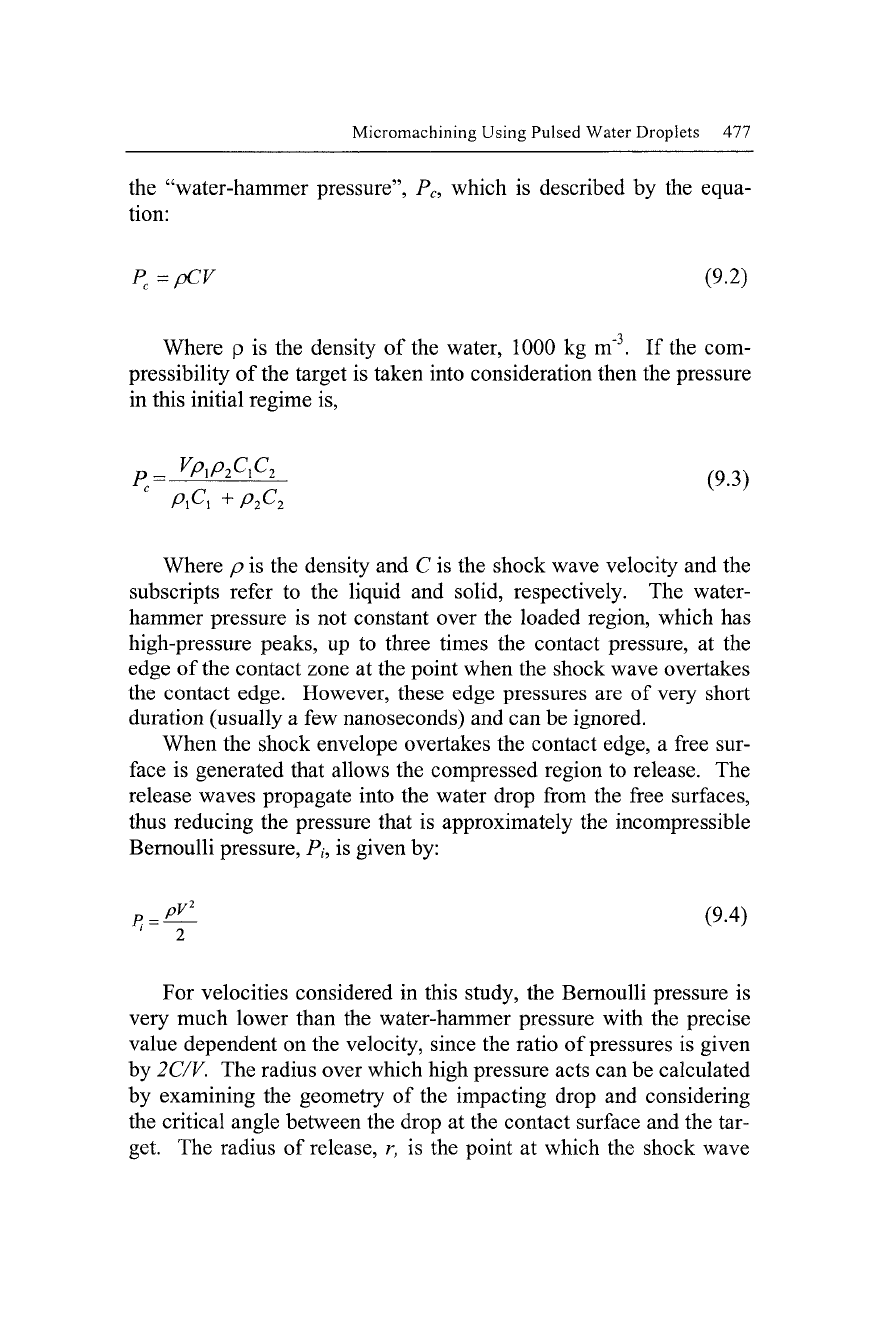
Micromachining Using Pulsed Water Droplets 477
the "water-hammer pressure", Pc, which is described by the equa-
tion:
Pc=pCV (9.2)
Where p is the density of the water, 1000 kg m"^ If the com-
pressibihty of the target is taken into consideration then the pressure
in this initial regime is.
P\Cx + P2C2
Where p is the density and C is the shock wave velocity and the
subscripts refer to the liquid and solid, respectively. The water-
hammer pressure is not constant over the loaded region, which has
high-pressure peaks, up to three times the contact pressure, at the
edge of the contact zone at the point when the shock wave overtakes
the contact edge. However, these edge pressures are of very short
duration (usually a few nanoseconds) and can be ignored.
When the shock envelope overtakes the contact edge, a free sur-
face is generated that allows the compressed region to release. The
release waves propagate into the water drop from the free surfaces,
thus reducing the pressure that is approximately the incompressible
Bernoulli pressure. Pi, is given by:
p,=^
(9.4)
2
For velocities considered in this study, the Bernoulli pressure is
very much lower than the water-hammer pressure with the precise
value dependent on the velocity, since the ratio of pressures is given
by 2C/V. The radius over which high pressure acts can be calculated
by examining the geometry of the impacting drop and considering
the critical angle between the drop at the contact surface and the tar-
get. The radius of release, r, is the point at which the shock wave
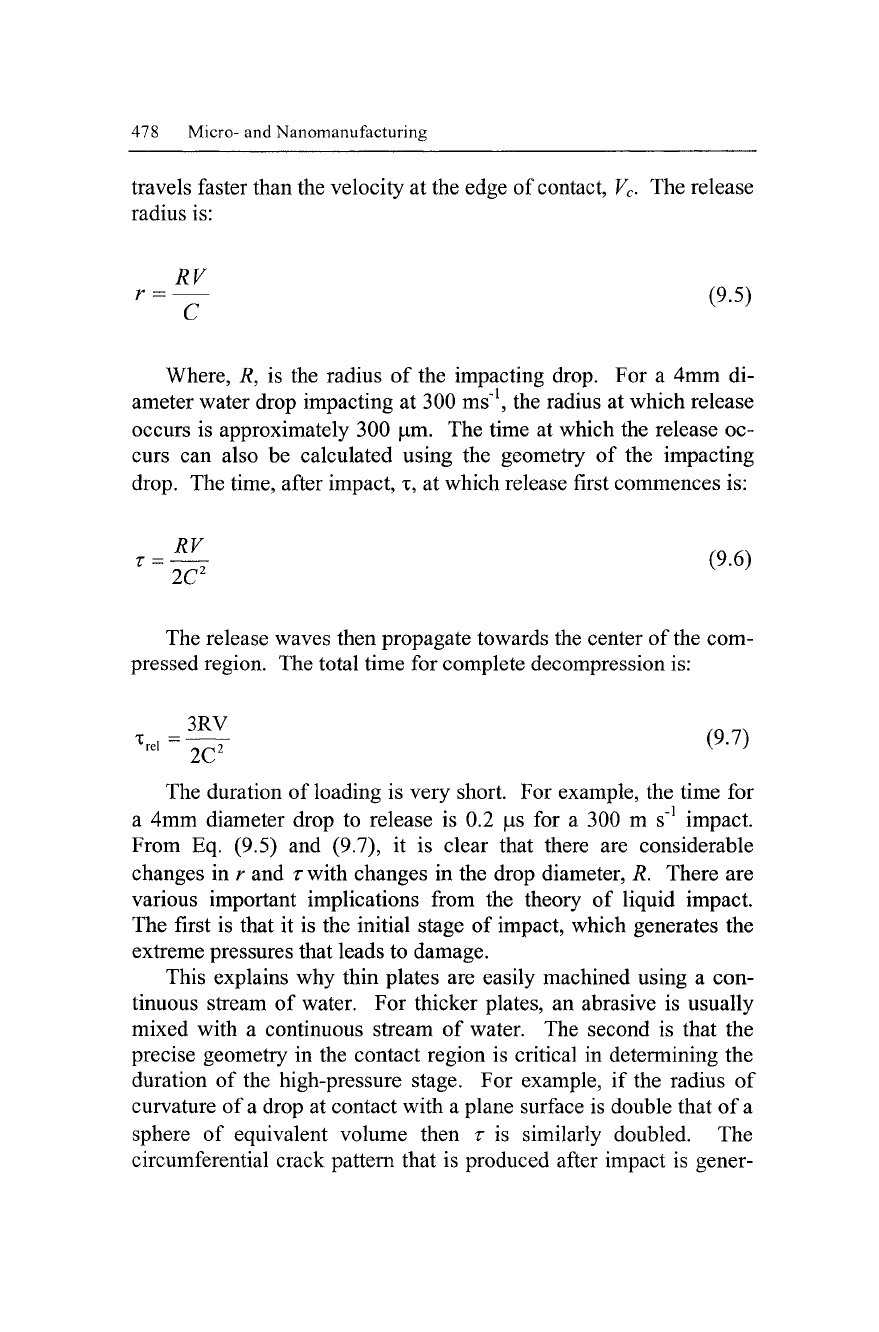
478 Micro- and Nanomanufacturing
travels faster than the velocity at the edge of contact,
Vc.
The release
radius is:
RV
r = — (9.5)
Where, R, is the radius of the impacting drop. For a 4mm di-
ameter water drop impacting at 300 ms"^ the radius at which release
occurs is approximately 300 |Lim. The time at which the release oc-
curs can also be calculated using the geometry of the impacting
drop.
The time, after impact, x, at which release first commences is:
r=^
(9.6)
The release waves then propagate towards the center of the com-
pressed region. The total time for complete decompression is:
The duration of loading is very short. For example, the time for
a 4mm diameter drop to release is 0.2
|LIS
for a 300 m s"^ impact.
From Eq. (9.5) and (9.7), it is clear that there are considerable
changes in r and
T
with changes in the drop diameter, R. There are
various important implications from the theory of liquid impact.
The first is that it is the initial stage of impact, which generates the
extreme pressures that leads to damage.
This explains why thin plates are easily machined using a con-
tinuous stream of water. For thicker plates, an abrasive is usually
mixed with a continuous stream of water. The second is that the
precise geometry in the contact region is critical in determining the
duration of the high-pressure stage. For example, if the radius of
curvature of a drop at contact with a plane surface is double that of a
sphere of equivalent volume then r is similarly doubled. The
circumferential crack pattern that is produced after impact is gener-
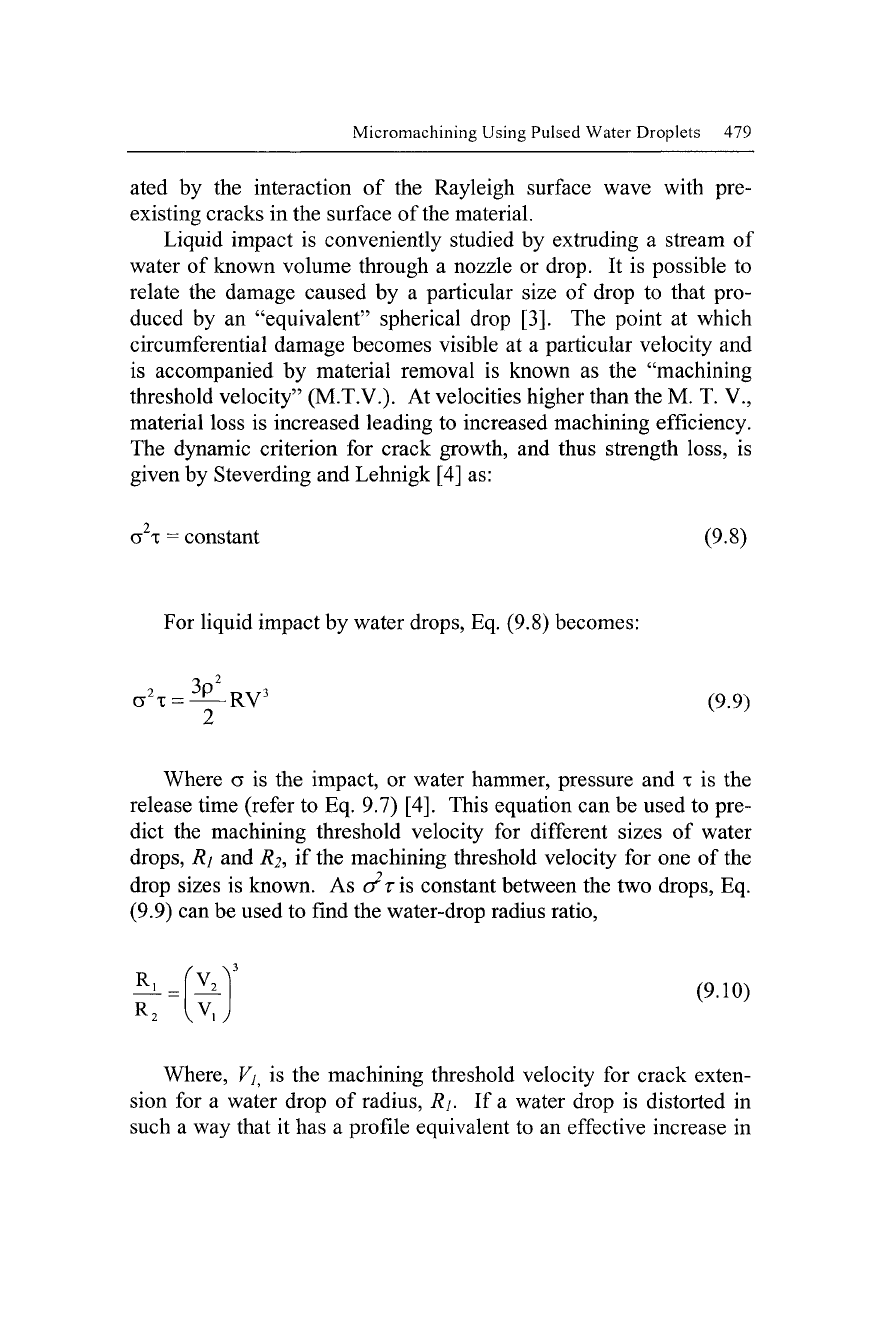
Micromachining Using Pulsed Water Droplets 479
ated by the interaction of the Rayleigh surface wave with pre-
existing cracks in the surface of the material.
Liquid impact is conveniently studied by extruding a stream of
water of known volume through a nozzle or drop. It is possible to
relate the damage caused by a particular size of drop to that pro-
duced by an "equivalent" spherical drop [3]. The point at which
circumferential damage becomes visible at a particular velocity and
is accompanied by material removal is known as the "machining
threshold velocity" (M.T.V.). At velocities higher than the M. T. V.,
material loss is increased leading to increased machining efficiency.
The dynamic criterion for crack growth, and thus strength loss, is
given by Steverding and Lehnigk [4] as:
a
T
= constant (9.8)
For liquid impact by water drops, Eq. (9.8) becomes:
a'T = ^RV' (9.9)
Where a is the impact, or water hammer, pressure and T is the
release time (refer to Eq. 9.7) [4]. This equation can be used to pre-
dict the machining threshold velocity for different sizes of water
drops,
Ri and
R2,
if the machining threshold velocity for one of the
drop sizes is known. As o^r is constant between the two drops, Eq.
(9.9) can be used to find the water-drop radius ratio.
R2
^V,^
vV,y
(9.10)
Where, Fy, is the machining threshold velocity for crack exten-
sion for a water drop of radius, i?/. If a water drop is distorted in
such a way that it has a profile equivalent to an effective increase in
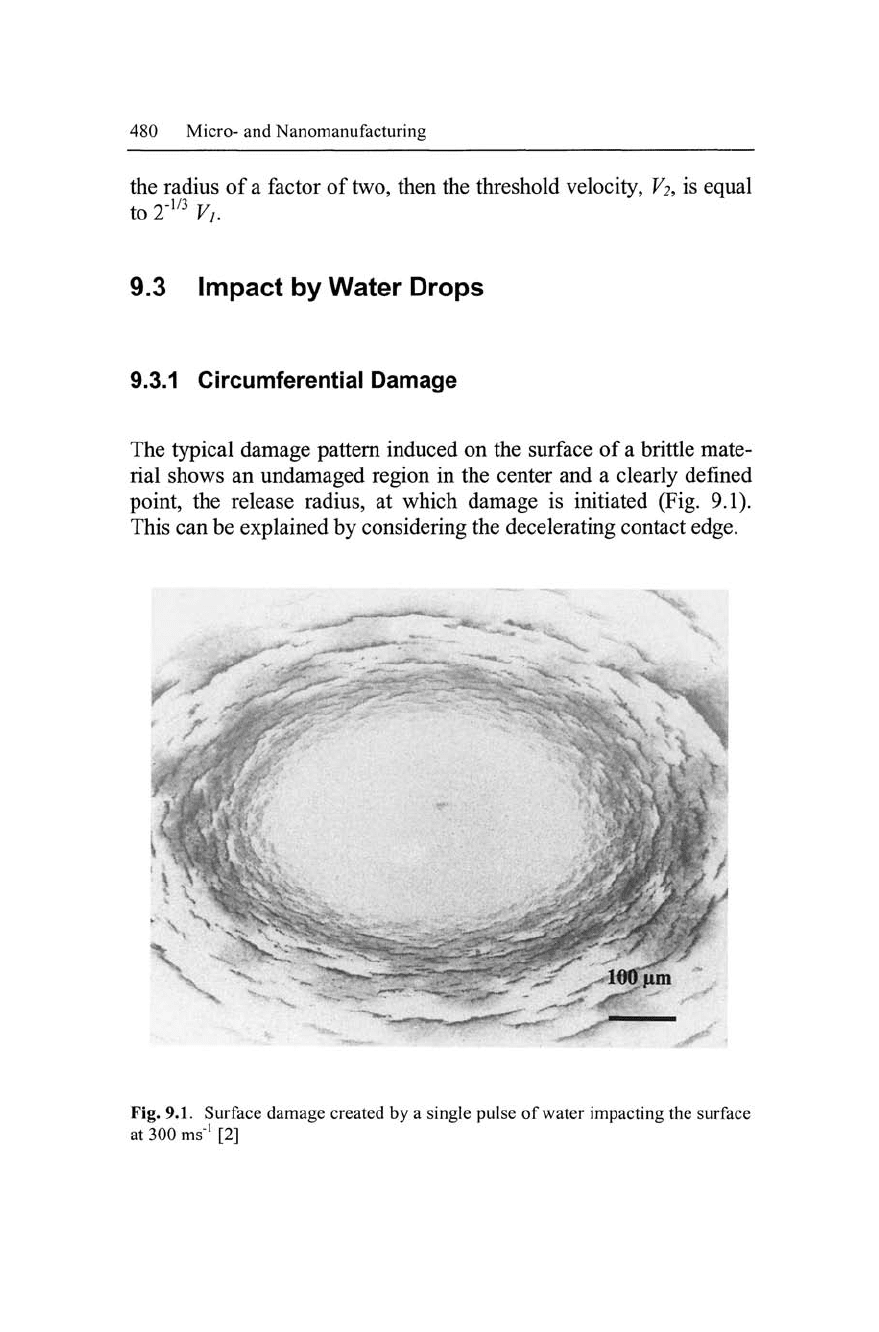
480 Micro- and Nanomanufacturing
the radius of a factor of two, then the threshold velocity, F2, is equal
to 2-'" Vj.
9.3 Impact by Water Drops
9.3.1 Circumferential Damage
The typical damage pattern induced on the surface of a brittle mate-
rial shows an undamaged region in the center and a clearly defined
point, the release radius, at which damage is initiated (Fig. 9.1).
This can be explained by considering the decelerating contact edge.
X
''*«,
"N,.
^
.V*-\:
Fig. 9.1. Surface damage created by a single pulse of water impacting the surface
at 300
ms-^
[2]
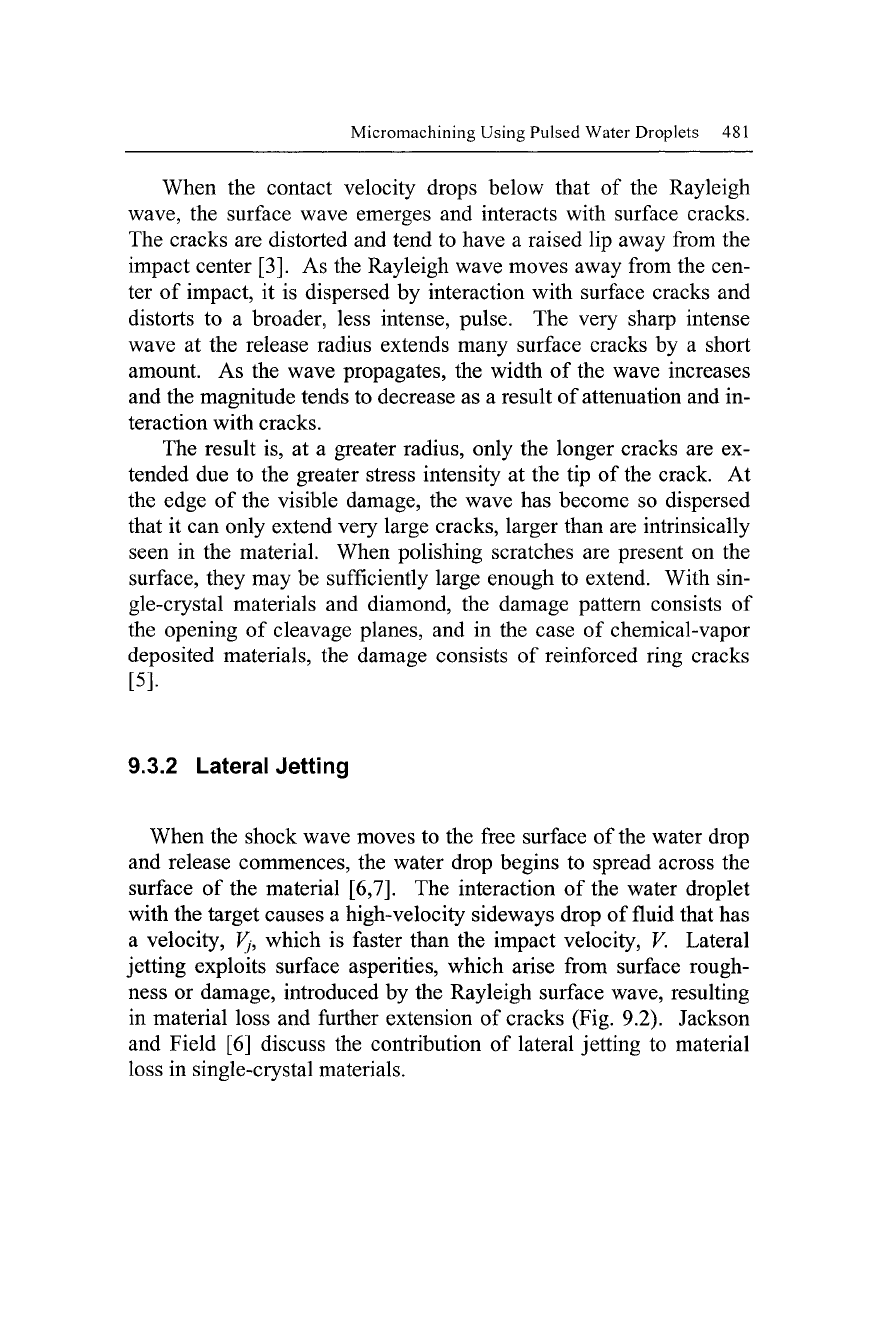
Micromachining Using Pulsed Water Droplets 481
When the contact velocity drops below that of the Rayleigh
wave, the surface wave emerges and interacts with surface cracks.
The cracks are distorted and tend to have a raised lip away from the
impact center [3]. As the Rayleigh wave moves away from the cen-
ter of impact, it is dispersed by interaction with surface cracks and
distorts to a broader, less intense, pulse. The very sharp intense
wave at the release radius extends many surface cracks by a short
amount. As the wave propagates, the width of the wave increases
and the magnitude tends to decrease as a result of attenuation and in-
teraction with cracks.
The result is, at a greater radius, only the longer cracks are ex-
tended due to the greater stress intensity at the tip of the crack. At
the edge of the visible damage, the wave has become so dispersed
that it can only extend very large cracks, larger than are intrinsically
seen in the material. When polishing scratches are present on the
surface, they may be sufficiently large enough to extend. With sin-
gle-crystal materials and diamond, the damage pattern consists of
the opening of cleavage planes, and in the case of chemical-vapor
deposited materials, the damage consists of reinforced ring cracks
[5].
9.3.2 Lateral Jetting
When the shock wave moves to the free surface of the water drop
and release commences, the water drop begins to spread across the
surface of the material
[6,7].
The interaction of the water droplet
with the target causes a high-velocity sideways drop of fluid that has
a velocity, Vj, which is faster than the impact velocity, V. Lateral
jetting exploits surface asperities, which arise from surface rough-
ness or damage, introduced by the Rayleigh surface wave, resulting
in material loss and further extension of cracks (Fig. 9.2). Jackson
and Field [6] discuss the contribution of lateral jetting to material
loss in single-crystal materials.
